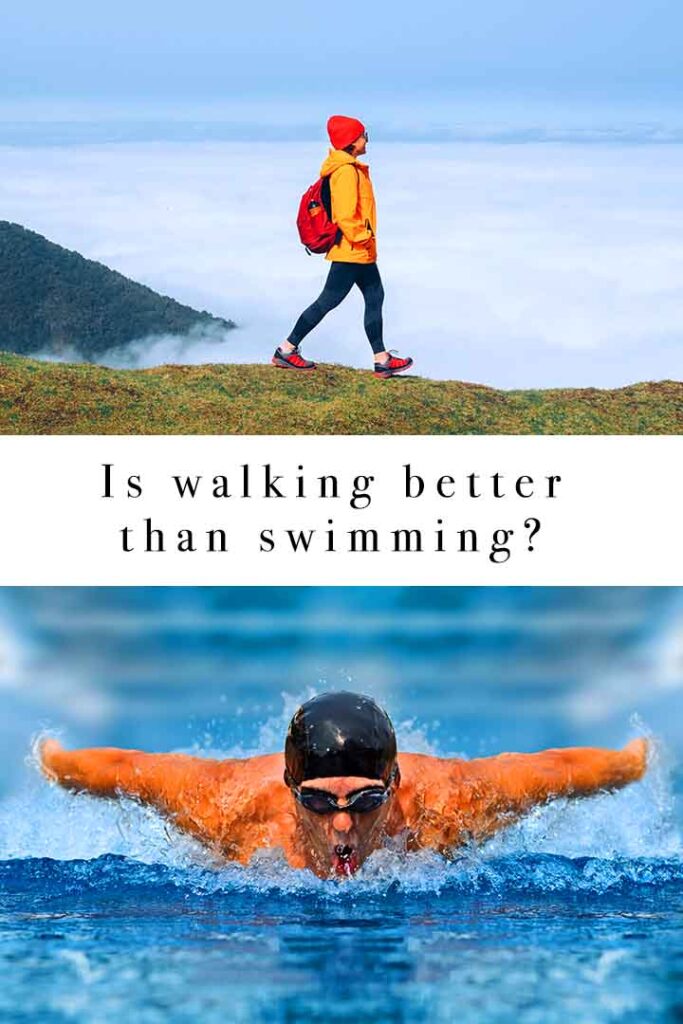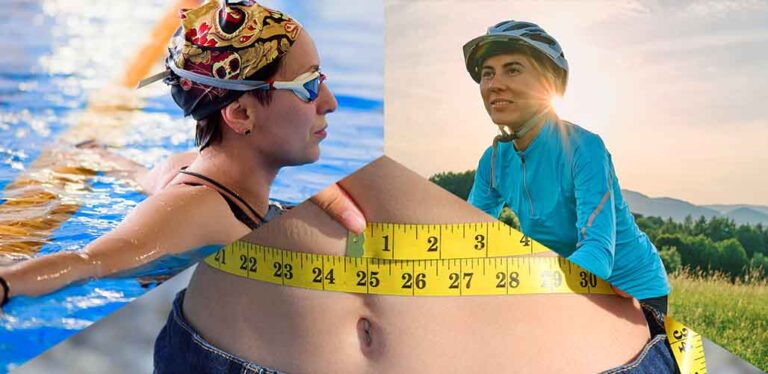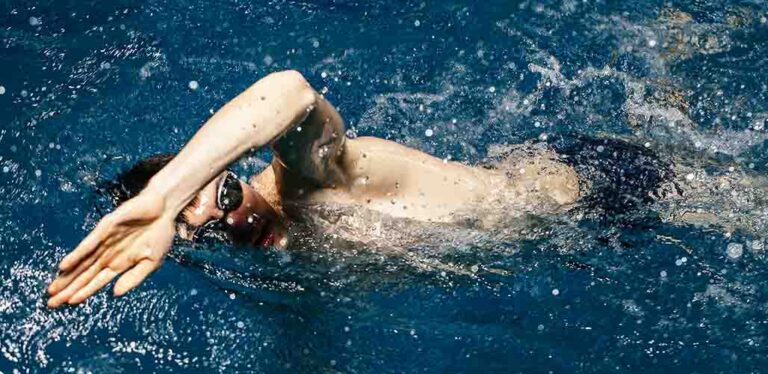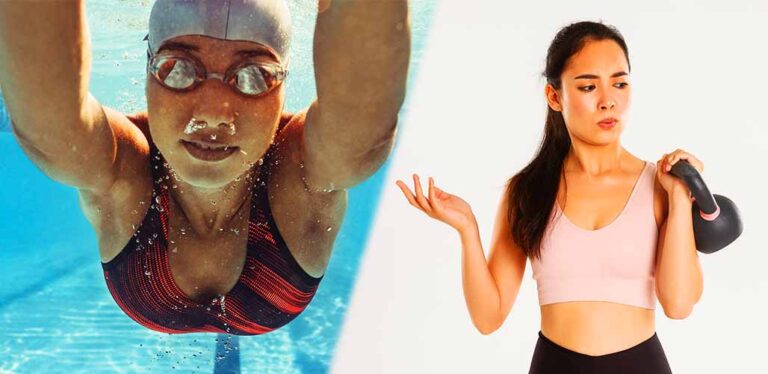Is Walking Better Than Swimming?
Walking and swimming are two popular forms of exercise, but is walking better than swimming? These two physical activities have many health benefits, but knowing which one is best for you and your fitness goals can be challenging. Studies reveal that swimming is better than walking for muscle tone and weight loss, offering a full body workout. However, swimming is not without its disadvantages, while walking has the added advantage that it is relatively easy to fit into your daily routine. Today I share top tips to help you decide which is the best sport for you and your athletic aims!
Contents
- Are walking and swimming good exercise?
- Walking vs swimming benefits
- Calories burned while walking vs swimming
- Downsides of walking for exercise
- Drawbacks of swimming for fitness

Is Walking and Swimming Good Exercise?
Both walking and swimming are forms of low-impact exercise that are easy on the joints and can help weight loss. They also strengthen the cardiovascular system, improve the heart and lungs, and increase your metabolism and immune system.
Building one or both of these activities into your fitness regime will help you sleep better and reduce stress, giving you a mental boost and increased energy levels. Walking and swimming are also excellent types of activities that can be enjoyed by the young and old alike.
Benefits of Walking
One of the most significant benefits of walking is that it is a form of exercise you can choose to do anywhere at any time and does not require any special facilities. It is also inexpensive as all you need is a comfortable pair of walking shoes and loose clothing.
Walking is a suggested workout for many overweight people or those with knee, ankle or back problems. Studies show that walking can reduce high blood pressure, high cholesterol, heart disease and diabetes while reducing body fat and weight. It also strengthens bones and muscles. Walking also increases our creative output and can open up a steady flow of ideas.
Benefits of Swimming
Swimming is an affordable form of exercise as most swimming pools offer reasonable rates compared to other activities. Swimming has the potential to burn more calories in a session than walking, making it ideal for those on a weight loss program.
Swimming is an excellent activity that works the whole body, toning muscles and increasing your heart rate without stressing the body, building strength and endurance. The different swimming strokes you can use provides variety to your workout, and each one focuses on separate muscles. These strokes include:
- Breaststroke
- Butterfly
- Backstroke
- Freestyle
Swimming is a good exercise option for those with injuries, arthritis, asthma or other conditions that make high-impact exercise difficult. It is also a safe activity for pregnant women. However, expectant mothers should check with their doctors before participating in any exercise program.
How Many Calories Do You Burn When Walking?
The number of calories you burn while walking depends on your body weight, how fast you walk and for how long. A person weighing between 120 to 140 pounds walking at a moderate speed for 30 minutes can lose 100 calories, burning 185 calories when walking at a faster pace. Those heavier in weight would expect to lose more.
You can multiply the calories you burn by walking uphill or upstairs as you work against gravity. The more you can work your muscles, the more calories you burn, so get your arms moving along with your legs!
Adding bursts of higher speeds during your walk increases the burn, developing more stamina and endurance. Walking to a fast-paced soundtrack boosts your mood and is a fantastic way to maintain momentum.
How Many Calories Can You Burn Swimming?
Your stroke type depends on how many calories you lose in a thirty-minute swimming session. Breaststroke is the least beneficial stroke burning around 200 calories, but it is a better cardiovascular workout than other strokes. It also tones the thighs, lower legs, hamstrings, triceps and chest muscles.
Backstroke burns 250 calories and is the best stroke for improving posture while toning the stomach, buttocks, legs and arms and improving the flexibility of the hips. Freestyle is the fastest swimming stroke that burns 300 calories, toning your stomach, shoulders, buttocks and back muscles.
The butterfly is the hardest but the most effective swimming stroke to learn, burning around 450 calories in a session. It is excellent for upper body strength, toning the chest, arms, stomach and back muscles, and increasing flexibility and suppleness, stretching the body to improve posture.
Disadvantages of Walking
Walking burns calories considerably slower than other forms of exercise, like swimming, as it is not as physically taxing. You would need to walk longer to lose weight, which may be difficult for those limited on time.
Also, you do not build so much muscle when walking, so you may need to engage in other activities like swimming to maximise muscle growth. Although walking helps maintain bone density, it is not a good activity for those with chronic joint pain.
Drawbacks of Swimming
Although swimming has numerous health benefits, one drawback is that it fails to increase bone density to any degree as being performed in water, the bones do not experience any weight bearing. Swimmers must therefore increase their bone density through other forms of activity like walking.
The other downside is that you must be able to swim and have access to a pool, preferably close to home, requiring one indoors during the colder months. Using a swimming pool costs money compared to walking and can often be crowded, which may restrict your training session.
The final drawback of swimming is that the pool water can cause mild skin and hair irritation because of the high concentration of chlorine.
Is Walking Better Than Swimming For You?
We have looked at the pros and cons of walking and swimming, but choosing one depends on your fitness aspirations. Swimming is the best option to lose weight and tone muscles. But if you want a more flexible and relaxed activity, then walking is for you.
However, by doing both walking and swimming, you will reap many benefits and become much healthier.
Learn More About Swimming and Fitness
- Is swimming enough exercise
- Swimming vs lifting weights
- Can you get fit just by swimming?
- Is it ok to swim every day?
- Does swimming get boring?
- Swimming vs Cycling
- Is swimming good for your brain?
Resources
- Harvard Medical School, Exercising in water: Big heart benefits and little downside, Harvard Health Publishing, 2016
- Yuan et al. Effects of 8-week swimming training on carotid arterial stiffness and hemodynamics in young overweight adults, BioMedical Engineering OnLine, 2016
- Sable et al. Comparative study of lung functions in swimmers and runners, National Library of Medicine, 2012
- Castro-Sanchez et al. Hydrotherapy for the Treatment of Pain in People with Multiple Sclerosis: A Randomized Controlled Trial, National Library of Medicine, 2012
- Hanson et al. Is there evidence that walking groups have health benefits? A systematic review and meta-analysis, British Journal of Sports Medicine, 2014
- Connolly et al. Low-volume high-intensity swim training is superior to high-volume low-intensity training in relation to insulin sensitivity and glucose control in inactive middle-aged women, Springer, 2016
- Oppezzo et al. Give Your Ideas Some Legs: The Positive Effect of Walking on Creative Thinking. Journal of Experimental Psychology: Learning, Memory, and Cognition, 2014







